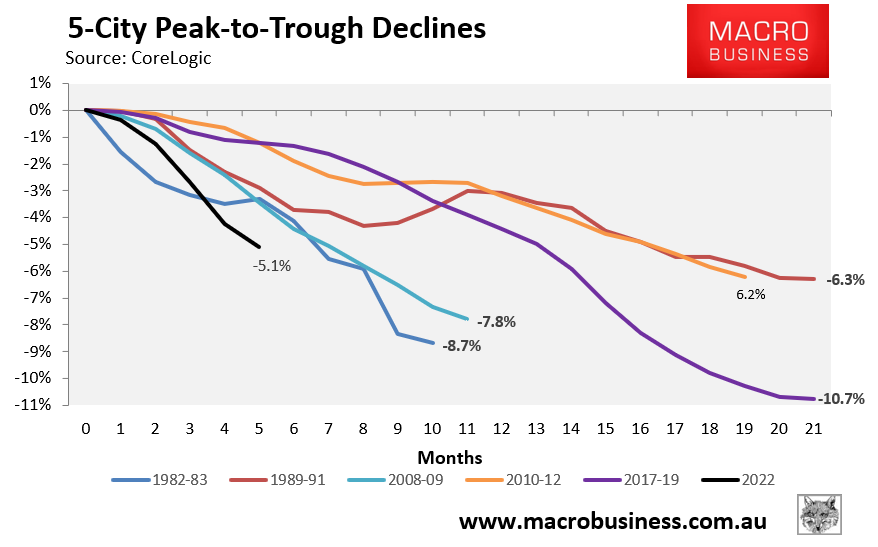According to CoreLogic records dating back to 1980, Australian dwelling values have never fallen by more than 11% across the combined capital cities.
The current housing downturn is plotted below (in black) against prior episodes and shows that dwelling values are falling at their fastest pace on record, but are only around halfway to matching the record decline posted between 2017-19:

The current downturn is the fastest on record.
The steepness of this price correction makes sense given the Reserve Bank of Australia (RBA) has hiked the official cash rate (OCR) by an extraordinary 2.25% since May – the sharpest rate of increase in history.
The aggressiveness of the RBA’s monetary tightening has prompted Jo Masters – chief economist at Barrenjoey – to forecast a record 16% peak-to-trough decline in national dwelling values, with Sydney prices to fall 25%:
Ms Masters said on Monday the central bank will cause a recession if it raised rates as aggressively as markets expect… [They] expect the cash rate to reach 3.3 per cent by the end of the year, before peaking at 3.9 per cent in April next year…
Barrenjoey expects the RBA to stop raising rates once the cash rate hits 2.85 per cent, well below consensus estimates and just 0.5 percentage points above its current level.
Ms Masters said a 2.85 per cent cash rate was consistent with a 25 per cent price fall in the “very leveraged” Sydney property market and a 16 per cent dip in values nationwide.
“It will be the largest and the longest house price correction in modern history…
Property prices would fall by a further 3 to 5 per cent if the RBA raised rates in line with market expectations, Barrenjoey estimates.
“I think one of the greatest learnings for economists from the pandemic was just how powerful interest rates are for the housing market”…
Jo Masters’ forecasts look reasonable.
This month’s monetary policy statement by the RBA noted that “the Board expects to increase interest rates further over the months ahead”.
Given there is a two to three-month lag between interest rate hikes and their impact on mortgage holders and the economy, this suggests that Australian dwelling values will continue to fall hard.
Ultimately, how far house prices fall will depend on whether the RBA stops its tightening early – as predicted by Jo Masters, CBA, AMP and NAB – or tightens harder in line with the bond market’s expectations.
Regardless, Australia is facing its biggest house price bust in modern history and should easily eclipse the 2017-19 episode.

